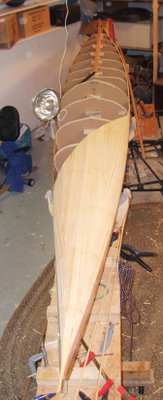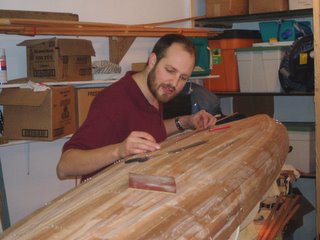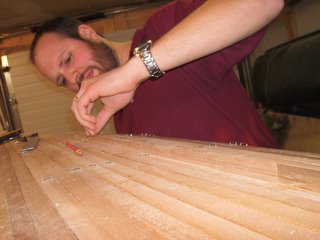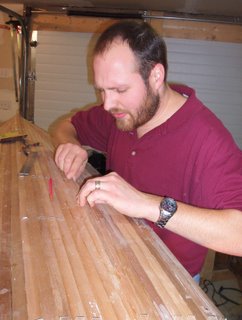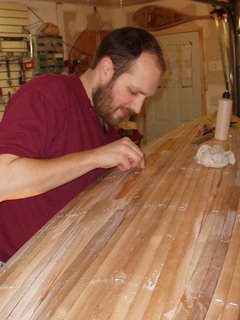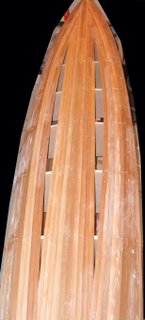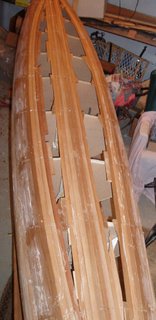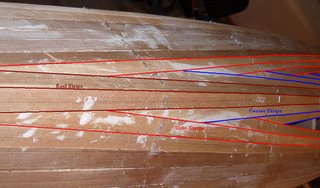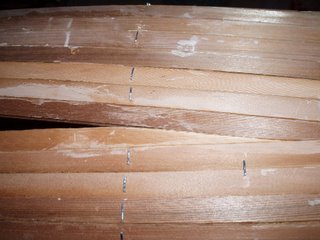With a less than 3 strip gap on each side of the keel, I got 3 more tight SOB strips in last night. Man oh man, my patience was being tested. First of all, I got the first strip tapered on end, then lined up and marked the taper on the other end. I then whittled the taper with a knife and tidied it up with the small block plane then tried it for fit - it seemed OK, just a tad long so a bit more with block plane and sand paper. The length was perfect, but the taper became concave due to the thin strip flexing away from the plane and so a big gap was left. So I decide to scrap that end and do it in two pieces so I cut it to have the joint line up with one of the forms. OK, get another piece - dang, that was pretty much my last piece of that particular shade of cedar so I won't find anything to match properly. More digging through the pile and I find one that's not too far off. So I put a new taper on the end - whittle, plane, plane, plane, sand, sand - voila! perfect fit. Great, now I just have to trim the other end so it makes a nice inconspicuous butt joint with the other piece. I marked the length with a pencil and take the strip out and cut it in a miter box, trimming it slightly long so that I can be assured of a tight fit. Back to the kayak, slip the tapered end in place and see how the other end lines up - Dang I'm an inch short. It seems there was another pencil mark on the strip from when I was lining things up previously before cutting the taper, and I cut to the wrong mark! At that point I was frustrated but in good humour so I decided to leave it, and cut a 1" piece to span the gap, thinking it might not look the best but most people wouldn't notice and if they did it would be a funny story we could all look back on and laugh at some day.

I then moved over to work on the other side of the keel line, where I thought perhaps I would have better karma. Again, I whittled & planed my taper onto one end, tested it for fit then moved to the other end to repeat the process. The strip being a tad too long, I planed another hair off of it and tested it again for fit and dang! It's too short! So, I cut the strip again at a form and then tapered a new strip to replace the end I cut off. This time when trimming the strip for length I made darn sure to not cut it too short and successfully managed to get it to fit without further incident. The second strip on that side (second last strip for that gap) was to fit into what by now amounts to a gap that is more tapered than straight. The problem is that in order to fit the strip into place you must fit it into the taper on one end so that the bead on the strip nests into the cove on the strip already in place (the cove has been cut off of the other strip it's tapered edge is mating against, and off of the strip being placed, but a cove still remains on the strip alongside the strip being placed), then bend the strip in the middle allowing it to bend mostly only in the untapered region and slip the second taper into place and see if it fits. Good luck. It was one heckuva fight to get that strip in place and I broke the cove quite a bit in my effort to do so. A second set of hands would have been very helpful. In my fight with the strip while gluing it in place, I broke the tip off of one of the tapers. This actually turned out to be a good thing. It was a 1.5" piece that broke off and it stayed nicely in place, at the tightest part of the taper which is the most difficult to slip into. I then had a much easier time dealing with the other 95% of the strip to slip it into place then mate the broken ends. I think on the other side I will try to do this second last strip in two halves, or ensure I have help (hint hint Rob), or probably both.
I was still a little troubled by that f*cked up piece on the other side so before calling it a night, I went back and cut a new piece to replace the too-short half of the strip. This went fairly well other than that I forgot to put a bead onto the taper so that it would fit into the cove of the piece it was butting against. Luckily, I realized it before I had trimmed the strip for length and was able to quickly plane a bead on and get it to fit.
So, my tally for the night was
- 9 tapers cut to fit,
- 6 tapers on 5 pieces of wood glued in place,
- 3 tapered ends cut off & discarded,
- 1 broken strip,
- 2 strips left to go on the left side,
- 1 strip left to go on the right side.
 For future reference, next time I would start cutting the cove & bead off a bit earlier, with 4 or 5 strips left in each gap since trying to fit short tapered strips into a cove is a mighty PITA.
For future reference, next time I would start cutting the cove & bead off a bit earlier, with 4 or 5 strips left in each gap since trying to fit short tapered strips into a cove is a mighty PITA.
 The above layout uses 1 layer on the inside and one on the outside with an extra layer on the bottom. The cutoffs should give me enough to work with for the other areas that need to be glassed. By my figuring, the above layout tells me that I need to get ~17 yards. I'll probably just round it up to 20 yards to make certain there is enough and keep the extra (assuming there is much extra) to go along with the extra epoxy so that I have a head start on the next boat! (Or all the other little things that one can build out of epoxy & fiberglass, such as a side view mirror for the car after my wife drops another boat on it.)
The above layout uses 1 layer on the inside and one on the outside with an extra layer on the bottom. The cutoffs should give me enough to work with for the other areas that need to be glassed. By my figuring, the above layout tells me that I need to get ~17 yards. I'll probably just round it up to 20 yards to make certain there is enough and keep the extra (assuming there is much extra) to go along with the extra epoxy so that I have a head start on the next boat! (Or all the other little things that one can build out of epoxy & fiberglass, such as a side view mirror for the car after my wife drops another boat on it.)




